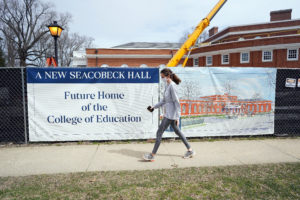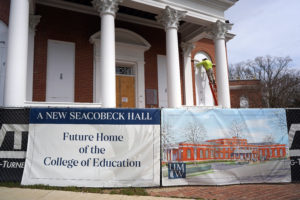Barbara Bishop Mann ’66 remembers making peanut butter and jelly crackers on linen-clad tables. Gayle Petro ’79 pumped pink frozen yogurt from a newfangled machine. Susan Doig ’91, M.Ed. ’06, and friends got creative, making potato skins by topping tubers with salad bar staples and cranking them through a grill-type toaster.

“A lot of bonding happened in this building,” said Doig, one of several alums who studied education at Mary Washington and returned this month to their old dining hall. They came back to add their names to a beam – also signed by COE students, faculty and staff – to be hoisted onto the roof of Seacobeck, the decades-long campus hub for generations of students.
Since meal service moved to the University Center in 2015, a $24 million renovation – in starts and stops – has brought Seacobeck full circle. Its planned re-opening early next year as the new home of the recently accredited College of Education (COE) will reflect UMW’s roots as a school for teachers, with a nod to the future of academia.
The state-of-the-art facilities will be “transformational” for students, said COE Dean Pete Kelly. Classrooms, collaborative areas, flexible event space and dynamic details like an open and airy two-story forum, with a “stadium stair,” running straight through the structure’s center will foster a sense of community … and possibility.
“An updated education environment will allow students to be exposed to new resources they’ll be able to use as teachers for their entire careers,” said Student Education Association President Vanessa Fickes ’22, who hopes to spend her final Mary Washington semester in the building.
Despite the Great Depression, Seacobeck – named for the Native American village once located on the site – opened with flair in spring 1931, one of four original buildings on campus. A central kitchen was flanked by two wings for dining, and a lobby known as the Dome Room was adorned with a marble fireplace and an ornate oval cut-out carved into the ceiling. The home economics department was tucked into the basement, along with plenty of storage.
For many years, dinners in Seacobeck were formal, with assigned seating and appropriate attire required of each of the students, all female, who endured lessons in social graces from the notoriously strict Dean of Women Nina Bushnell. Two extra wings for food service were later added, and mealtimes took on a more casual, cafeteria-type ambience.
Basement spaces were reimagined to house entities like Design Services and the student-run newspaper. And eventually, one Seacobeck wing was set aside for faculty and staff dining. “It was a beautiful building, and each room was different,” said longtime cashier Patricia Moore. “The architecture was absolutely gorgeous.”

Hanbury Architects worked closely with UMW’s Department of Historic Preservation, Whiting-Turner Construction and the Virginia Department of Historic Resources to ensure original features, like Corinthian-style columns, ornate crown molding and mammoth arched windows, were saved.
“Historic Preservation has definitely been a valuable resource and a great department to team with,” said UMW Capital Outlay Program Director Gary Hobson, who has led the renovation of Seacobeck.
Dean Kelly envisions the beehive-like building – with team rooms and the latest technology, including a maker space – abuzz with UMW education students, who have been far flung, taking classes in James Farmer Hall and other buildings, including graduate level courses at UMW’s Stafford campus.
COE’s new digs, he said, will pull together the program, which offers a bevy of initial licensure, master’s degree, professional development, endorsement and certificate programs, and holds agreements with community partners to help budding teachers complete their degrees.

The renovated building “will facilitate the development of a community of students, faculty and staff focused on excellence in teacher development,” Kelly said, bringing it back to its roots as a place of bonding. “It’s really great to see Seacobeck come together.”




As a parent of two students, one graduating this year and the second to follow in 2023, I have witnessed UMW always operating fully as one class act. Best wishes to all education majors as they enjoy their new digs this fall.
Congratulations!
Christina Rupsch (Lanzafame)
Wow! What a gorgeous space. Congratulations.
I’m surprised nobody mentioned that UMW was originally a normal school (a teacher’s college), so those are important roots not mentioned. And throughout the years, as a normal school, as the women’s college of UVA and now UMW, we have had very high scholastic standards – and now the education department, really how UMW started, will have the space to flourish with excellence.
Thanks for your comment and for reading UMW stories! Just wanted to point out that the University’s history as a teachers’ school is mentioned in the third paragraph: “Its planned re-opening early next year as the new home of the recently accredited College of Education (COE) will reflect UMW’s roots as a school for teachers, with a nod to the future of academia.” The new home for the College of Education, as Dean Kelly would say, is a much-needed piece of good news.
Wow such a nice area, loved it
UMW’s EDU undergrad students are always more than prepared to teach on Day 1. It’s truly a top notch program!
The walk to Seacobeck was always so beautiful. I remember the gorgeous tulip trees near the arched bridge. We had formal teas in the parlor. I waited tables there my sophomore year. When the dishwasher broke paper plates allowed beet servings to leave eight red stains on the fresh linen table cloths. Assigned tablemates remained the same throughout the year and became good friends. We sang for birthdays and cut corners on slices of ice cream on Sundays. A grand old building.
I remember meals at Seacobeck very well. You could meet your friends under the dome, then get into the cafeteria line. Tables featured white linen tablecloths and napkins, though I was there in the post-Nina Bushnell era. Best of all, you could stop by the basement dining room until 10 a.m. for “late breakfast” which consisted of coffee and very tasty doughnuts. Early breakfast was served in the upstairs dining rooms and offered healthier fare.
I was a 1972 grad as well. I would rush from the stables to eat dinner, still wearing my riding boots and breeches. I wish I had languished over meals more in college, but I was in a rush to classes or to study. It was an amazing time with beautiful buildings to cherish.
Yes, Seacobek was primarily the dining hall, but my sophomore year it was my dorm. The basement hall housed an eclectic group of us. Meals were just a few steps away. A memorable year!
I remember walking over the bridge to Seacobeck and meeting a large group of students coming back chanting ,”liver, liver!” and we would turn around and skip dinner that night. I also remember waiting on the step down to the basement and singing, “Here we are like birds in the wilderness” waiting for the dining room doors to open. Also, the riding students had to sit ar their own table because of the odor of their clothes.
How did the “keggers” in the basement get left out of this story?! I also remember the pile of backpacks in the Dome Room…appreciated the Honor Code for that.